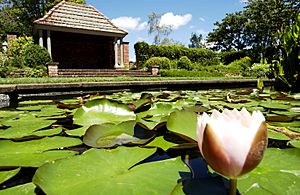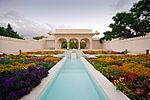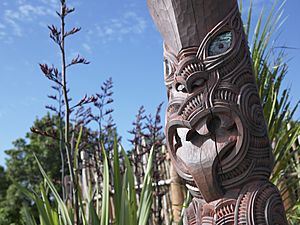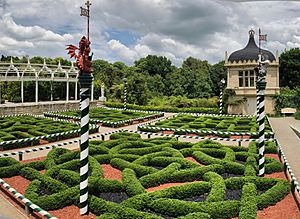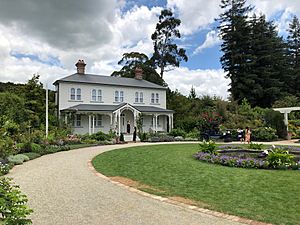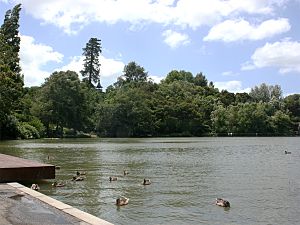Hamilton Gardens facts for kids
Quick facts for kids Hamilton Gardens |
|
|---|---|
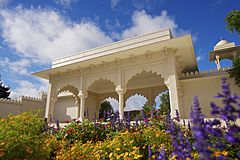 |
|
| Location | Hamilton East Hamilton |
| Created | 1960s |
| Operated by | Hamilton City Council |
| Visitors | One million per year |
Hamilton Gardens is a super cool public garden in Hamilton, New Zealand. It's owned and run by the Hamilton City Council. This huge 54-hectare park sits right on the banks of the Waikato River. It has amazing enclosed gardens, big open lawns, a beautiful lake, and even a convention centre. It's the most popular place to visit in the Waikato region, attracting over a million people and hosting more than 2,000 events every year!
Even though it looks like a botanical garden, Hamilton Gardens is actually different. Instead of just showing different plants, it features 21 special gardens. These gardens show how people from different cultures and times thought about gardens, their beliefs, and their ways of life. These unique gardens are grouped into five main collections: Paradise, Productive, Fantasy, Cultivar, and Landscape gardens. There's even space for new gardens to be built in the future!
The gardens started to be developed in the early 1960s. Back then, it was just the city's old waste disposal site. The first big garden, the Rogers Rose Garden, opened in 1971. Since 1982, many new areas have been opened for everyone to enjoy. Today, you can also find a lovely lake walkway and a cool waterfall lookout.
Awards and Recognition
Hamilton Gardens Rose
A special rose, named Hamilton Gardens, was created in 2008. It was found at Hamilton Gardens as a natural change from another rose called Paddy Stephens. Like its parent, the Hamilton Gardens rose has long stems, pretty blooms, and is very good at resisting diseases. The New Zealand Rose Society says its color is "an appealing blend of apricot, pink and cream." It grows to about 1.5 meters tall. This rose was voted the 10th most popular Hybrid Tea Rose in a New Zealand survey in 2009. It has also been shown at big rose events at Hamilton Gardens, like the Pacific Rose Bowl Festival.
International Garden Tourism Awards
Hamilton Gardens won the "Garden of the Year" award at the International Garden Tourism Awards in Metz, France in 2014. A group of garden experts from all over the world chose it as the winner. Other famous gardens that have won this award include Singapore Botanic Gardens and the Gardens of Trauttmansdorff Castle in Merano, Italy.
Richard Benfield, who leads the World Garden Tourism Network, praised the gardens. He loved their plants, their unique design with separate areas, their educational value, and how amazing they look. He said visitors find surprises in each garden. He also noted how the gardens connect to the river valley and central Hamilton. Benfield called the gardens unique in the world and "visually spectacular."
Friends of Hamilton Gardens
The Friends of Hamilton Gardens is a group of volunteers. They help support and develop the gardens. These amazing volunteers have been involved in almost all the new gardens and projects. They have also run the Hamilton Gardens Information Centre since the early 1990s. They staff it every day of the year, except for Good Friday and Christmas Day.
Donors
Many groups and people have helped raise money and organize things at the gardens. The Hamilton Gardens Building Trust raised money for the Hamilton Gardens Pavilion. The Waikato Rose Society supported the Rogers Rose Garden. The Waikato Herb Society helped with the Herb Garden, and the Waikato Camellia Society supported the Camellia Garden. Kathleen Braithwaite, a former Hamilton mayor, gave a lot of money for the English Flower Garden and future projects. Muriel House also gave a lot of money for the Modernist Garden. The Russian Bell Tower Trust raised funds for the Hamilton Gardens Russian Bell Tower.
Different organizations also help with special events. The Garden World Trust organized big Gardenworld Festivals. The Waikato Garden Festival Trust has organized festivals and fundraising events. The Hamilton Gardens Entertainment Trust used to organize the yearly Turtle Lake Concert to raise money. The Hamilton Garden Summer Festival Foundation has organized the Hamilton Gardens Arts Festival since its second year. The Pacific Rose Bowl Trust was set up to manage the Pacific Rose Bowl Festival.
Gardens
Paradise Garden Collection
The Paradise Garden Collection shows how gardeners have tried to create a perfect place on Earth. The word 'paradise' comes from an old Persian word meaning 'enclosed garden'. There are six amazing gardens in this collection:
- The Chinese Scholar's Garden looks like gardens from the 10th to 12th century Sung Dynasty. These gardens were designed to be natural and spark your imagination. It has a tiled entrance, a winding path, a cave, a bridge, and a bamboo forest. It leads to a red pavilion overlooking the Waikato River.
- The Japanese Garden of Contemplation is like gardens from the 14th to 16th century. These were made for quiet thinking and study. It has carefully placed stones, a traditional pavilion, and a calm pond.
- The English Flower Garden is an example of 19th-century English gardens. They were used to collect plants and arrange seasonal colors. It has walls and hedges that create "outdoor rooms," seats, and fountains. The main area has a pavilion, lawn, and pond.
- The Modernist Garden is a late 20th-century American-style garden. It's designed for outdoor living and inspired by modern art. This garden has a curved pond, yellow outdoor chairs, a raised deck, and a big mural of Marilyn Monroe.
- The Italian Renaissance Garden is based on gardens from the 15th or 16th century. These gardens aimed to control and improve nature, drawing ideas from Greek, Roman, Medieval, and Islamic styles. It has a Romulus and Remus statue, an upper level with trellises, a lower level with flower beds, and an outdoor theater.
- The Indian Char Bagh Garden is like the 16th and 17th-century Islamic gardens built by Mughal royalty. These were escapes from hot, dry weather. It has geometric flower beds in many colors, below a chalk-colored Indian pavilion.
Cultivar Garden Collection
The Cultivar Garden Collection is the closest Hamilton Gardens gets to being a true botanical garden. These gardens feature well-known plants that have been specially chosen and grown over time by plant collectors and breeders. There are six gardens in this collection:
- The Rogers Rose Garden has different types of roses from various periods in history. It's one of only 62 rose gardens worldwide to win an Award of Garden Excellence! Since 2001, the New Zealand Rose of the Year Trials and the Pacific Rose Bowl Festival have been held here.
- The Rhododendron Lawn shows different kinds of azaleas and rhododendron plants.
- The Hammond Camellia Garden has a variety of Camellia plants, from wild species to modern types.
- The Victorian Flower Garden displays delicate plants chosen for their bright, tropical colors. The flowers are shown in beds and glasshouses, just like in 19th-century gardens.
- The New Zealand Cultivar Garden features native plants that have been specially grown for their colorful leaves.
- The Dutch Renaissance Garden represents a 17th-century Dutch garden, from a time when many new plants were brought into Europe.
Productive Garden Collection
The Productive Garden Collection shows how people use plants for different purposes. Each garden here represents how gardening is both a natural process and a cultural practice. This collection includes the Herb Garden, the Kitchen Garden, Te Parapara Māori Garden, and the Sustainable Backyard Garden. There are currently four gardens in this collection, with one more planned.
- The Herb Garden has plants used for food, makeup, perfume, and medicine.
- The Kitchen Garden grows vegetables and small fruits. It's looked after by students and staff from the Waikato Institute of Technology. It's based on traditional European kitchen gardens from the 18th and 19th centuries.
- The Sustainable Backyard is a small, enclosed garden. It shows how to grow food in a sustainable way in a small backyard space.
- Te Parapara is a traditional Māori garden. It shows how local Māori people grew food along the Waikato River before Europeans arrived. It's on the site of an old Māori settlement with the same name. This area was known for its fertile gardens and sacred rituals for harvesting food. It was also the home of a famous Ngāti Wairere chief named Haanui. This garden is part of the Hamilton City Council's plan to develop and restore the Waikato River.
Landscape Garden Collection
The Landscape Garden Collection makes up the outer parts of Hamilton Gardens. These gardens are inspired by different ways of thinking about nature. They show the connection between people and the natural world.
There are six areas in this collection:
- The Bussaco Woodland is a forest with quiet viewing spots. It's similar to woodlands found in many ancient cultures. This area includes an outdoor chapel, a statue, and river views. It feels separate from the rest of Hamilton Gardens.
- The Hamilton East Park Cemetery, opened in 1863, is an example of a "Rural Park Cemetery." This movement in the late 19th and early 20th centuries led to some of the first public parks. The cemetery follows a balanced English style, influenced by John Claudius Loudon. Many of Hamilton's first British settlers are buried here.
- The Echo Bank Bush is an area of native bush. It's kept in its natural state, following the 20th-century idea of conservation.
- The Valley Walk is a 20th-century natural-looking garden. It uses native Waikato plants. The plants are chosen to fit the natural habitat, which means less weeding and chemicals are needed, and the plants grow better and are more diverse.
- The Hillside Lawn is a huge lawn on top of Hamilton's old city rubbish dump. It shows how landscapes can be restored after being used for industrial purposes.
- The Baroque Formal Garden is a planned garden. It will be like the classical 17th to 18th-century French gardens. These gardens were designed to show off the power and wealth of their owners.
Fantasy Garden Collection
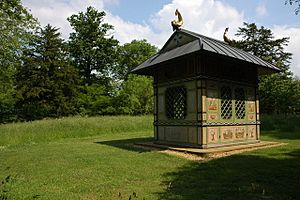
The Fantasy Garden Collection shows how imagination has been used in garden design. It also shows how gardens can make people feel imaginative and dream. There are nine gardens in this collection, some already built and some planned.
- The Chinoiserie Garden uses elements of Chinoiserie. This was a European trend in the late 18th and 19th centuries to interpret Oriental designs. The main part, the Chinoiserie Pavilion, is based on the Chinese House built in 1738 at Stowe Landscape Gardens in the United Kingdom. It mixes Chinese and Japanese designs with European ideas. It includes the Chinoiserie, a Bottle Gate, and special Chinoiserie seats.
- The Tropical Garden has plants from other warm parts of the world. These tropical-looking plants are quite hard to grow in Waikato's climate. The garden has 200 different plant types and over 8,000 individual plants! It includes a vertical garden wall with 4,000 plant pockets around a pond. You can also hear tropical bird calls playing from hidden speakers sometimes.
- The Surrealist Garden, which opened in February 2020, is a mystery garden designed to play tricks on your mind. It has a big lawn with strange, giant topiary figures called "trons." The garden furniture is five times bigger than normal, and there were even plans for oversized flowers that could talk!
- The Tudor Garden is like a 16th-century English Renaissance garden. It has red and black stone knot gardens, Elizabethan walls, and a stone pavilion. The design is based on old drawings and shows how rich people loved geometric patterns and symbols. This garden, which opened in 2015, has cool sculptures of a Phoenix, Unicorn, Griffin, Dragon, Satyr, Centaur, Sea serpent, and Bottom.
- The Concept Garden is a 21st-century garden that represents a single idea, like conceptual art. It opened in 2018. It has a hidden meaning related to a Māori proverb: "He peke tangata, apa he peke titoki," which means "the human family lives on, while the branch of a titoki falls and decays."
- The Picturesque Garden is a wild-looking landscape with artificial old-fashioned features. It represents 18th-century Romantic period garden styles. It opened in November 2019 and borders the Waikato River, offering great river views.
- The Mansfield Garden is a recreation of a New Zealand lawn party from the early 20th century. It's based on Katherine Mansfield's short story, The Garden Party. This garden, which opened in November 2018, includes a tent on a tennis court, a karaka hedge, a lily pond, long tables with white tablecloths, and the front of an old 19th-century house.
Visitors
Hamilton Gardens is located between the Waikato River and Cobham Drive State Highway 1. You can get in through two vehicle gates and several walking paths. The enclosed gardens are open every day during daylight hours. Entry and parking are free! Buses run every hour between Hamilton Gardens and the Hamilton Transport Centre. You can also take a Waikato River Explorer cruise between Memorial Park, the Hamilton Gardens jetty, and Mystery Creek. Hamilton Gardens is even part of national and regional tours, including a combined day trip with the Hobbiton Movie Set.
People visit the Gardens from all over the world, including Australia, the United Kingdom, Europe, Asia, North America, and South America. Many local visitors come from Auckland, the Waikato region, the Bay of Plenty, and Taranaki. Over 1.1 million people visited in the year up to July 2017, which was a 13.5% increase from the year before!
Events and Facilities
Events
The Hamilton Gardens Arts Festival has been held every February since 1998. This festival includes many different events in the gardens and buildings, like concerts, art shows, and a pop-up bar.
The gardens host many other events too! These include the special Pacific Rose Bowl Festival in November, the National Painting and Printmaking Awards in February, the Great Pumpkin Carnival in March, the Hamilton Fringe Festival in late March, and Stations of the Cross before Easter.
The gardens also have yearly gardening events focusing on bonsai, chrysanthemums, daffodils, dahlias, lilies, orchids, tulips, and roses. Other annual shows include the Doll and Teddy Bear Show, the Salvation Army Christmas Concert, the Scarecrow Festival, the Waikato Maths Competition, and the Waikato Science Fair.
The Hamilton Gardens Pavilion is a popular place for concerts, antique fairs, collectible shows, and model railway exhibitions. It's also used for business breakfasts, psychic nights, and health seminars. Plus, it regularly hosts fitness expos, wedding expos, natural health expos, and trade shows.
Local communities use Hamilton Gardens for religious ceremonies, cultural gatherings, and formal balls.
The gardens also host Anzac Day commemorations, model boat regattas, karate competitions, pipe band competitions, and fun runs.
All the gardens and buildings can be booked for weddings and ceremonies. Hamilton Gardens even provides an experienced wedding coordinator to help with arrangements. There's a fee to book enclosed gardens for weddings, but it's free to take wedding photos inside the gardens.
Amenities and Facilities
At the center of the gardens is the Hamilton Gardens Pavilion. This is a big convention and event center that can seat 650 people in three different rooms. The pavilion also has the Hamilton Gardens Information Centre. This center is run by staff and volunteers and sells seasonal plants, helps with tourism bookings, and offers souvenirs.
The Waikato Institute of Technology Horticulture Education Centre at Hamilton Gardens offers professional courses in arboriculture (tree care), horticulture (plant growing), floristry (flower arranging), landscape design, and horticultural technology. They also have an annual open day for students who want to learn more.
A main feature of Hamilton Gardens is Turtle Lake. This is an artificial lake and a home for ducks. It has a stage on one side and a walkway over the water on the other. The four-meter horsetail waterfall flowing into the lake is the only waterfall in Hamilton! There's also a cafe, restaurant, and catering company at the lake. They serve coffees, snacks, meals, and ice creams. The cafe's outdoor dining area looks out onto the lake.
Toilets are located in the Hamilton Gardens Pavilion and at the Gate 1 entrance. There are seats all around the site, and most gardens have sheltered spots if it rains. Most gardens are accessible for wheelchairs, mobility scooters, and pushchairs. You can find maps, apps, brochures, and guided tours in different languages. There's even an activity sheet for children! You can find picnic spots near the Waikato River, Turtle Lake, and in some gardens. Dogs are not allowed in enclosed areas, but there is a special off-leash dog walking area east of the Turtle Lake car park.
Jetty and Cruises
The old jetty below the Gate 1 car park was one of 10 jetties on the Waikato River in Hamilton. Because it was in bad shape, a new one was built and opened in June 2018. This new jetty is used by cruises from Memorial Park and Swarbrick Landing, which started in 2012.
Images for kids


